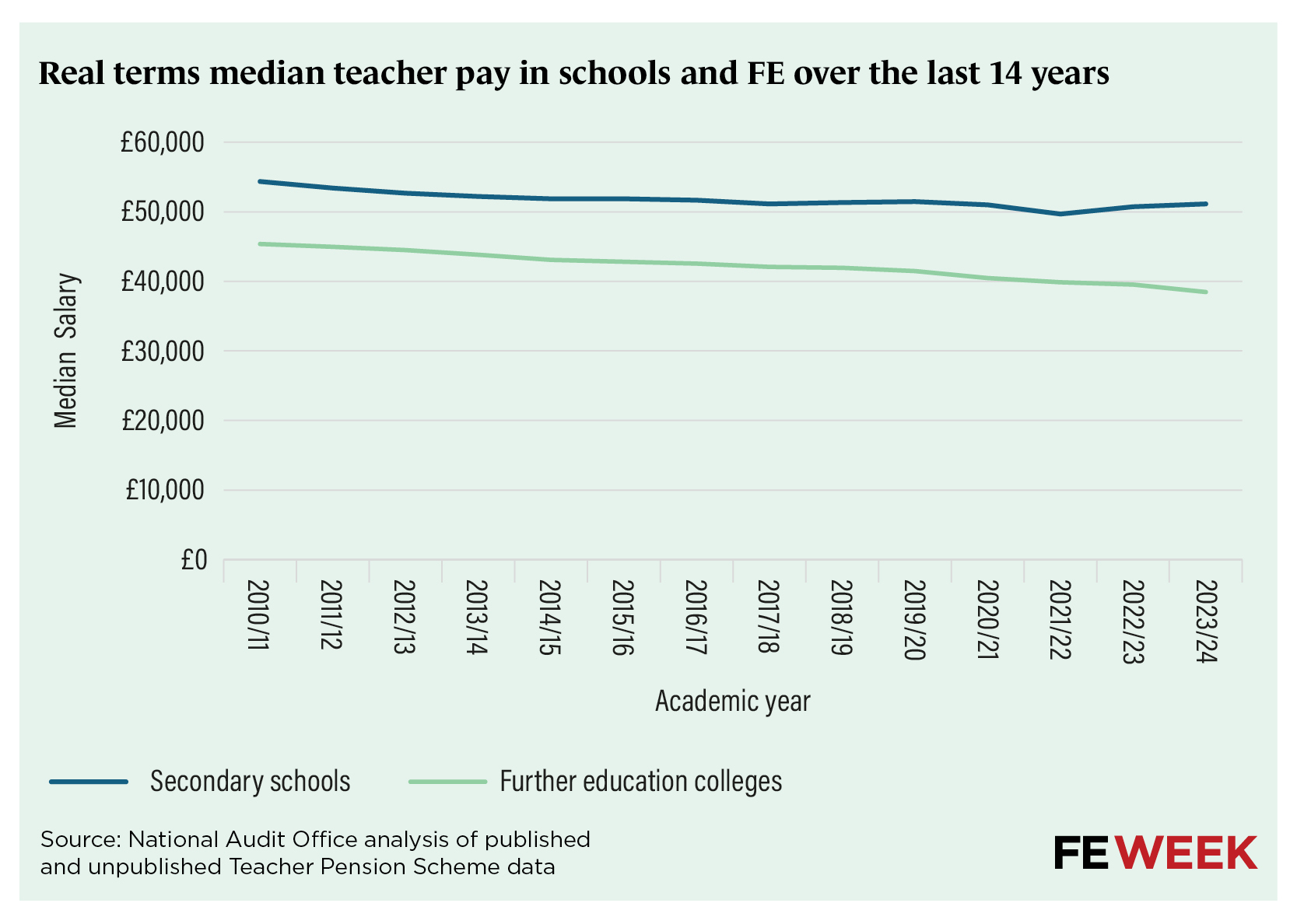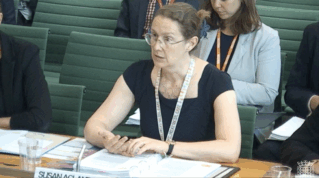The government’s spending watchdog has urged ministers to publish their plan for achieving Labour’s manifesto pledge of recruiting 6,500 additional teachers – but revealed meeting the target will not be enough to address worsening shortages in colleges.
MPs today warned that it will be “very challenging” to meet the goal as a report by the National Audit Office found the Department for Education has estimated between 8,400 and 12,400 FE teachers are needed by 2028/29 to meet the rising demographic needs and to deliver T Levels.
It comes after the new Labour government pledged last summer to recruit an additional 6,500 teachers for schools and further education colleges by the end of Parliament, or spring 2029 at the latest.
Today’s NAO report said the FE sector is the “worst affected” type of education provider by long-term recruitment pressures with 5.1 of every 100 teaching roles vacant in general FE colleges. This amounts to 2,500 empty positions in colleges as opposed to 1,500 schoolteacher vacancies.
The report found issues with DfE’s data collection of the FE workforce, the department’s minor influence in setting teacher pay and vagueness around setting the initial 6,500 recruitment target.
It recommended that the government “fully assess, balance and manage” the implications for value for money, affordability, responding to future teaching requirements and demographics, as well as providing “greater transparency” around what the 6,500 pledge means in practice for colleges.
DfE cannot explain where 6,500 figure came from
The NAO revealed that Labour could not explain how it decided on the 6,500-recruitment figure.
DfE also did not explain how the target would be split across mainstream schools, special schools and further education colleges nor did it allude how many extra teachers are expected each year in each setting.
“As such, it is not clear if, or how, this number relates to known and forecast shortages across different settings,” the report said.
Sir Geoffrey Clifton-Brown, chair of the Public Accounts Committee, said that meeting the government’s pledge for 6,500 more teachers will be “very challenging”.
“Even if met, it is not clear that this will be enough to fix the nationwide shortage of teachers amidst growing numbers of students,” he said.
The NAO recommended that DfE bring together a cross-sector “package of initiatives that are affordable, cost-effective, and get at the root causes of challenges”.
“Although its 2019 recruitment and retention strategy focused on schools, DfE is now thinking about these challenges from a cross-system perspective, and in relation to their relative cost and impact, to help focus its efforts. The government’s pledge to provide an additional 6,500 teachers by the end of this Parliament has added urgency to this work,” the report said.
Pepe Di’Iasio, general secretary of the Association of School and College Leaders, said: “Virtually every school and college in the country is having to manage teacher shortages because of long-standing nationwide recruitment and retention problems.
“The last government failed to address this issue and it is not clear how the current government intends to achieve its pledge of recruiting 6,500 new teachers or whether this will be anywhere near enough.”
Di’Iasio added: “We’ve had no end of piecemeal policies but the overriding factors remain unresolved – pay levels are not competitive enough and workload and stress is driving teachers out of the profession.”
Recruiting 6,500 teachers ‘unlikely’ until pay gap solved
While DfE has no influence on setting pay rates in FE, it does have “some influence” over teacher salaries, such as supporting Treasury in setting funding allocations and teacher funding packages as part of wider government spending decisions, the report said.
The NAO highlighted that the difference in median salary between schools and FE teachers was around £10,000 but is further exacerbated compared with industry salaries (see below graph).
For example, engineering professionals in industry are paid over £8,000 more than an equivalent further education teacher, and IT professionals earn over £11,000 more, DfE analysis suggests.
NAO authors also examined a host of financial and non-financial incentives to encourage teachers to stay after finding “particular challenges” around retention of FE teachers early in their career.
For example, of 6,970 new teachers in 2018, only 43 per cent were still teaching after five years.
It warned that DfE cannot realistically rely on pay alone, referencing previous research from the National Foundation for Educational Research (NFER) that while increasing pay for all teachers could deliver the required number, “it would require an additional £4.9 billion per year by 2026/27”.
DfE told the NAO that it is “primarily considering” expanding existing financial incentives that it knows are effective to meet the 6,500 figure.
The NAO report said: “Its proposals will need to include requests to scale up existing financial initiatives to help meet the 6,500 target, alongside core funding so settings can pay the salaries of the additional teachers. It expects to agree a plan in summer 2025, a year after the pledge was announced and four years before the latest date for the end of this Parliament, the timeframe for delivering the pledge.”
David Hughes, chief executive of Association of Colleges, said achieving DfE’s estimated of between 8,400 to 12,400 more teachers by 2028/29 is “increasingly unlikely” until the pay gap is solved, hopefully at the upcoming spending review.
“Achieving that growth looks increasingly unlikely unless and until the pay gap between colleges and schools and with industry are closed,” he said. “Other activities can and do help, but in the end the pay gap becomes the biggest barrier. Without addressing that quickly, DfE will have to acknowledge that government ambitions on its missions will be severely hampered.”

In July 2023, DfE announced additional further education funding of £185 million for 2023-24 and £285 million for 2024-25, which the majority of colleges used for prioritising the recruitment and retention of teaching staff and giving a uniform percentage pay rise to existing teaching staff.
In the 2024 budget statement, an additional £300 million for FE for 2025-26 was announced, but the NAO was told most of the funding is needed cover the additional teaching costs associated with rising 16 to 19 student numbers, rather than used to increase salaries.
“DfE recognises that the lack of funding for further education teacher pay could put at risk its growth and opportunity missions, alongside its commitment to recruit 6,500 new teachers,” the report added.
Data and forecasting ‘lack supporting evidence’
The Department for Education told the NAO that secondary school student numbers rose from 3.2 million to 3.7 between 2015/16 and 2023/24 and are set to increase and peak in 2028.
“These numbers will subsequently impact further education, which DfE predicts will need an additional 8,400 to 12,400 teachers by 2028/29, compared with 2020/21 levels, to meet demographic pressures and deliver T Levels,” the report said.
But the NAO found that DfE does not use its further education workforce model, which is supposed identify gaps and trends in the availability of teachers, to set targets for how many teachers it needs.
The report said the FE model is more “uncertain” than the schools model and “often lack supporting evidence”.
The model assumes teacher numbers will remain constant over time, which was an assumption DfE acknowledged was “highly unlikely” to be correct but has not compared its forecast of teacher numbers with more recent data.
DfE told the NAO authors that it is reviewing its assumptions but could not provide further details, given the early stages of the work.
The NAO recommended more cross-sector data collection after it found different methodologies and differing data collection timescales between the existing annual school workforce census and further education workforce data collection.
The report added that DfE is exploring ways to monitor progress more frequently, such as quarterly updates for schools to overcome the time lag of data being published. However, it said this would not be relevant to further education.
A DfE spokesperson said: “A high-quality FE workforce is critical to delivering the skills learners need to get on in life and drive growth in our economy, and this is why we are investing significantly in FE teachers.
“Despite challenging fiscal circumstances, the Government has announced that we will be spending over £400m more on 16-19 education in the 2025-26 financial year. Early career teachers in key technical subjects are also eligible to receive up to £6,000 per year under our Targeted Retention Incentive scheme. This will support colleges to recruit and retain the skilled teachers they need and drive our Plan for Change.”
“Colleges are responsible for managing their own budgets, including setting staff pay.”














Your thoughts